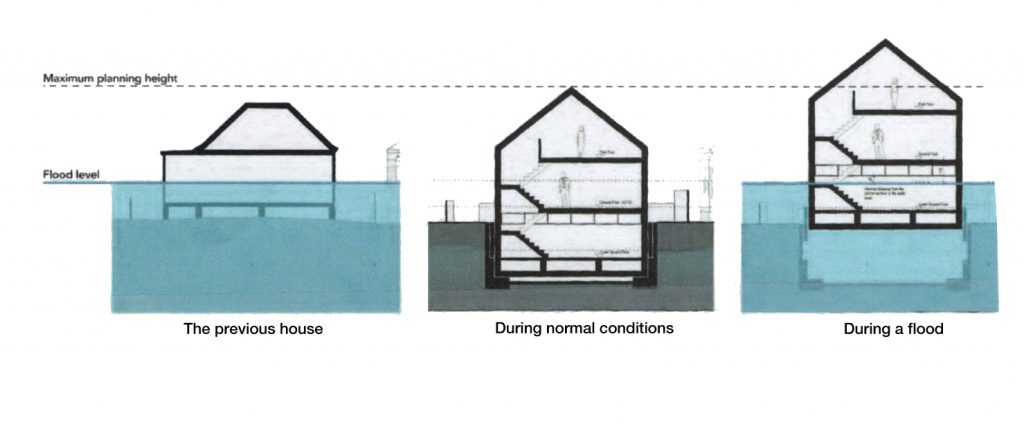
According to a recent Newsday article on the effects of climate change, Long Island is becoming shorter and narrower. Up close we can see the rise in sea level on our docks as high tides become higher, roads flood on sunny days and more intense storms have become the rule rather than the exception. As land mass disappears the world population has significantly increased with the need for more living space.
To house more people the choices are to build taller buildings, use unbuildable property and/or work with the tides by building houses that work with water. Architects and engineers in Asia, Europe, Australia and the US have built houses that work with the tides and float like a ship in areas subject to flooding. Floating houses are permanently in the water. Amphibious houses are fastened to mooring posts and rest on concrete foundations. Floating houses have a concrete float with Styrofoam inside for stability. The amphibious house, secured on thick steel vertical posts, will float up to 18 feet at a high tide and then settle back down to its concrete foundation when the water level goes down. The cost to build a three level house with three bedrooms is about 20% to 25% higher than the cost of conventional housing the same size.

Techniques used in building dams and bridges are used to build amphibious houses. They use caissons and the vertical columns driven into the ground to keep the houses from moving sideways are made of strong steel and once in place, they are filled with special concrete that works in a salt atmosphere. The vertical poles that hold the house in place are the same kind of poles used to anchor the partially submerged Apple Store in Singapore.
In the Netherlands where close to half the country is below sea level, they have been working since 1997 on their “room for the river” program. Their first amphibious houses were built in 2005. By 2020 there were several hundred (what they call) “water houses.” The Dutch houses were required to be able to float up vertically about 17 to 18 feet, with flexible connections to water, gas, electricity and other supplies.
In Seattle, there are 480 floating houses in Richardson Bay. In the past five years, the growing demand for this housing has kept moving prices up about 20% a year for existing houses. A current resident bought her first floating house in Southern California in 1991 and now is a real estate salesperson for the floating house community.
It seemed to start as a novelty – hotels put a few rooms underwater, a restaurant, and a spa where customers could watch fish swim by and now a $2.8 million floating house called “Floating Seahorse” has been built, to be followed by a $3.3 million house in Dubai. In Sweden, the Utter Inn offers a single room floating accommodation. You can sun yourself on the deck and the upper level features a small kitchen with sleeping on the lower level with glass walls looking out into the lake.

What must it be like to live on the water without paying the high real estate taxes that people in New York and New Jersey pay and without the major concern of flooding damage when a major storm threatens? What most people might think about first is their investment. Would tying up your income until the house is paid for justify giving up what we see as valuables cluttering up our attics, cellars, garages and storage units? You have to turn into a minimalist to live in one of these houses. If you wanted to add a piano or some heavy exercise equipment it would mean realigning the underside of your house to rebalance it.
In a climate that includes hot summers and freezing, cold winters, would a very long walk from the marina parking lot, down a ramp that depending on the tide might be almost perpendicular and then a long walk down a boardwalk be unappealing to you? How about the same trip on a cold, rainy night with the dog for his evening walk?If UPS and Amazon Prime trucks are weekly visitors now, you’d need a place for them to leave packages that would be open later in the day/evening than the usual marina office is open. You would probably want to rent a box at the local UPS store for your packages.
If the marina area experiences a storm or accident related power failure it’s likely not only your lights, heat, cooling and computer would be affected. Your plumbing is likely to run on pumps that would be affected. The gray water leaving the house and the fresh water supply coming in would be run by pumps that need working electricity. It’s not likely that a marina would want you to have a generator to have your own power.
Before signing up to live in a floating house at a marina you would need to know the level of their internet service. Maybe state of the art service that equals what you had at home ten years ago is OK for your needs but with people working from home and kids doing schoolwork online, you need enough internet speed to support the whole family’s needs.
If you are a younger person with small children you would likely want them to be wearing life jackets when they play outside on your dock or someone else’s dock. Even after they learn to swim, when they play around the perimeter of the house they could easily fall in. If you are an older person you might have to think someone in the family might need an ambulance. How far would you be from where the ambulance would park and the EMTs would have to carry the person on a stretcher?
On the plus side, floating houses have no yards so you could sell the lawnmower, weedwacker and other garden tools. Some of us live on the water because we need to see it, hear it, smell it and be close enough to feel the humidity when you take the dog out. Just think – when you step off the community dock onto your dock after work and change into shorts or a bathing suit, you grab your canoe/ kayak/paddleboard and the work day turns into adventure time.
In case fish find food in your waters you might be able to fish from the dock around your house for your dinner. You might start using the camera on your phone to catch sunrises or sunsets or both that you never noticed before. You might find new friends right next door. Meeting new people is easier when you live just ten feet away from each other.
Changing weather patterns have created the need for new approaches and solutions to the problems they create. At the same time the weather patterns are changing, the King Tides
(When the orbits and alignment of the earth, moon and sun combine to produce the highest tides of the year) and the wobbly time of the moon have come together to give us unusually high tides. All these together have cost New Yorkers as we lose property through erosion, have to replenish the dunes at Gilgo and Long Beach and pay for raising Dune Road. Residents in low south shore areas who already have had tidal problems and whose kitchen appliances are raised on cement blocks are looking at higher insurance premiums in the future.
New approaches and solutions will have to be part of our future. Part of acknowledging that we have a problem is learning how to deal with it. We need strategies that will help us stay comfortable in a place many of us have always called “home.” These houses could build up real estate values in low lying areas and with the right planting, act as sponges that would mitigate the damage from flooding.
